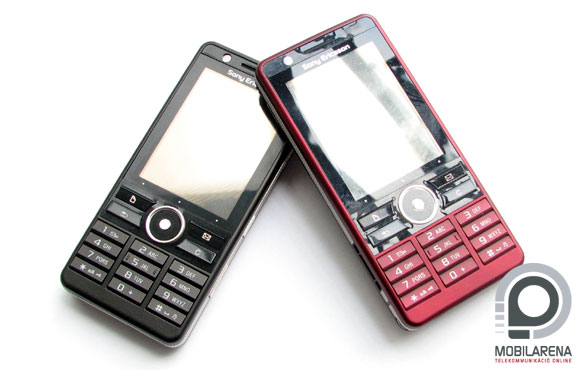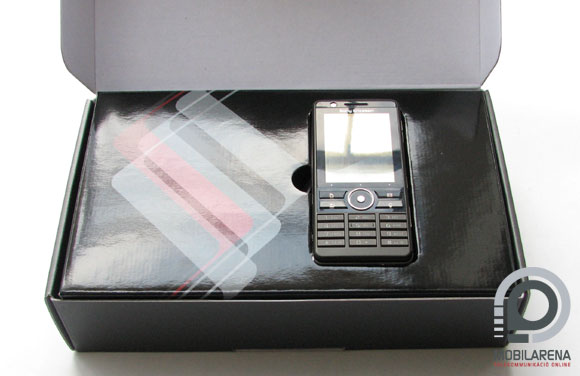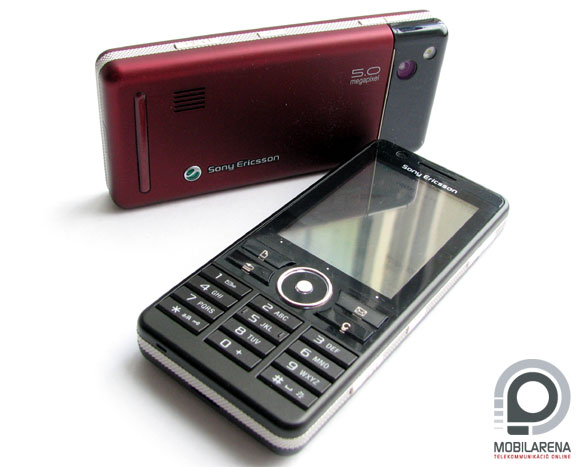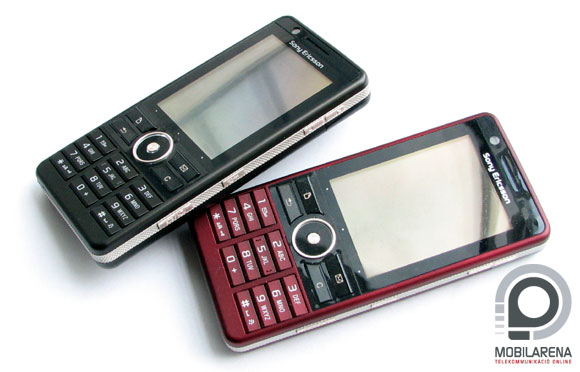The G series
February 10, 2008, Barcelona. We had a pleasant weather when at a Sunday evening we went with my colleague Bocha to a small event hall at the edge of the town to have a look at Sony Ericsson’s great announcements for this year. This is where Xperia has been introduced, which has undoubtedly been the hero of the evening, but everyone had suspected that the other newcomers, two phones from the G series, will probably be launched earlier.
Since then G502 has also joined G700 and G900, so officially this new series from Sony Ericsson has three members. (But some sources say that G702, codenamed Beibei, is also coming soon.) Common aspects of G700 and G900 are that they both use Symbian as their operating system and have a touchscreen. They also have real buttons too; this is why members of the G series look more like phones than PDAs. This is no problem, as even though this design requires larger handsets, but having real buttons too besides the touchscreen will be very useful during daily use.
I’ve been using G900 for almost two weeks now, and even though this phone is not perfect either (as such a phone doesn’t exist), we still got acquainted enough to give me enough inspiration to write a longer review of it. Fortunately I had lots of experience with UIQ-based Sony Ericsson phones lately, so I could analyze this one knowing the features of previous ones, but in the meantime we had for testing lots of S60 Nokia handsets too, not mentioning the Windows-based devices that are gaining more and more features. G900 is somehow a competitor in both classes, but we could also say that it’s kind of halfway between them, as there are still no touchscreen Nokia phones available and Windows-based handsets rarely have both a touchscreen and real buttons (with the exception of a few ASUS products).

After a lots of organizing and asking for help we managed to acquire a black dark brown edition too besides the wine-red one, and this brown phone had the final software version (this is going to be shipped to stores), came with the full package (it was untouched, I just loved tampering with it) having all the accessories, so we can finally show the packaging too. Besides the phone the box also contained a charger, a headset, a USB cable and an extremely thick stock of papers too. Unfortunately I was looking in vain for a memory card.

Exterior
Even my friends who have glasses have kept asking: what kind of Sony Ericsson is this? It has been clear for them too that such a design can only be the product of the Japanese-Swedish manufacturer, the brick shape is absolutely characteristic to them, just like the button layout and the design of the front cover. It’s a fact that it’s not small, but it’s neither too thick (only 13 mm).
The huge touchscreen is what dominates the landscape on the front; the 2.4” screen uses a 240 x 320 resolution. Above this there is the manufacturer’s logo and the frontal camera, but the area below the display is much more interesting, as it begins with three small dots: these are the replacements for the function keys. Although one usually starts with tampering with the dots, it’s much better to target the bottom part of the screen in order to have the desired effect.

The circle-shaped navigation button has 5 directions, as its center can be pressed. There are four buttons around it, with the notes and back keys on the left and the messaging hotkey and the C key on the right. This is where the black frame surrounding the display ends, from here we can only see the usual numeric keypad. Even though they might seem a bit thin, they are cleverly bent upwards, so it’s easy to distinguish them, there are no problems with typing; maybe pressing the keys on the bottom row is a bit difficult, as it’s worth keeping the phone differently in our hands this time, to avoid dropping it.

There is a silver colored, reticular stripe running along the sides of G900. The situation is quite simple on the left side, this is where the manufacturer’s standard data connector is placed, along with the hook for the neckstrap, while from the top left corner we can take out the stylus, which is not telescopic, and it might be a bit short sometimes. On the right side of the phone we can see the volume control keys, the camera’s hotkey and the button used for (un)locking the keypad. There is nothing on the bottom of the phone, while on its top only the power button is placed.
There is not much extra on the back, but the fact that we are facing a 5 megapixel camera is printed in quite large letters. This would really be incredible if we were to see only the lens’ size and the way it’s emphasized. The cover has to be cracked off (this method is somehow forced on newer Sony Ericsson phones), and if we manage to take it off than we can access the memory expansion slot, which accepts an M2 card, as usual.

There are no problems with assembly quality, even though the case is made of plastic; it only starts to crack if we keep pressing it really hard. G900 is the typical phone which usually no one worries too much about, unlike one that’s made of shiny, brushed aluminum. This is because fingerprints will be present on the display anyway, and if G900 acquires some kind of dirt, than it can be cleaned simply with our fingers.
Hardware, menu
Let’s begin with the bad news. G900 has the same 208 MHz CPU that P1i had and this hasn’t been anything new even in the phone from a year ago. The RAM is 128 MB large, the exact size previous UIQ models had, so the question is righteous: where is the progress? Nokia is already at 369 MHz, Windows-based stuffs usually have 400 MHz, but there already are handsets with 524 MHz, or even 600 MHz processors.

Yes, the Reader might righteously think: speed is not the best part of G900. Still, there has been some kind of optimization since P1i, as it’s not that slow, but there are features that need 1-2 seconds to be accessed. This is strange as according to JBenchmark the performance is a bit lower than P1i’s. I have been happy though, that running multiple tasks at the same time didn’t stress the phone at all; if there has been enough free memory than everything ran in perfect tranquility – and reliably. But let’s see a video on which I’d like to show how much time does changing a theme take and how fast do messaging and the camera’s software launch. The phone had no other tasks running in the background.
Hirdetés
The user interface, however, has been developed very much. Although there is a stylus, we can still find features in G900’s menu that are intended to make navigation by fingers simple and easy. This is primarily due to the large icons and the main screen has also changed a lot. There has already been a scrollbar in the bottom row, but this became larger and all icons have a panel which pops up immediately, so we can access frequently used features much faster. This is the default setting, but we can switch the main screen’s view to business mode; this is when the well-known stripe of smaller icons comes up, along with the good old today menu, in which we can find missed events and calendar entries.

Let’s just stick to the panel version, as this is a well-thought-out system. Besides our favorite numbers, custom menu, messaging and calendar we can also add other panels including the music player, the photos folder, the list of alarms, the list of web bookmarks, the RSS reader, the world clock and the task list too. Of course in this case we have more icons to scroll through in order to reach a specific function, but it’s still great.

The main menu itself also has larger icons; the designers were smart enough to place only 9 icons here. Themes can still be changed, of course along with the icons. The submenus have a list view, but in this case we don’t need the touchscreen anyway, we can solve everything without tapping the screen. So the UIQ system is highly customizable and easy to use in G900. I personally missed only a double-speed processor and environmental profiles, as these aren’t present.
Basic features
The phonebook’s size is unlimited – that is it can grow until there is free memory. A contact can have many phone numbers, email and postal address, comment, birth date, function, company and voice commands assigned to every detail. Names cannot be sorted only by first and last name, but also by company and function. Font size can be set in three steps and in case of those contacts that have more details assigned to them, we can access the different phone numbers or email address by scrolling sideways.

Just like in the case of the contact list, we can change font size at messaging too. The inbox can be sorted by date, sender, size and type. SMS and MMS messages share the same folder, while email messages arrive in a different one. When setting up a new mailbox there is a wizard to help the user configuring it. In case of well-known providers it’s enough to enter the address and the phone tries to solve other settings through the Internet by itself. The number of messages we can store depends only on the amount of free memory we have. The email software handles attachments too; I couldn’t find any limitation in size (theoretically the maximum size is 99999 KB) and there were no problems with authenticated SMTP servers.

Text entry is done by default using the bit hard buttons, but there would be no use of a touchscreen if we couldn’t write using it. Besides handwriting recognition we can also use a virtual keyboard, but I think that most users will stick with the conventional keys.

The calendar also lives up to expectations. We can store four kinds of entries: meeting, reminder, full-day schedule or anniversary. The latter one is where birthdays from the contact list get transferred to. All four types of entries ask for different kind of data, but the software doesn’t warn us of conflicting events, we can see these in the week and day view. The alarm clock handles three time points, that can be repetitive, but unfortunately these do not work if the phone is turned off (although they do function in flight mode). We can find other features in the organizer menu: there is a stopwatch, a calculator (not scientific), task list, PDF reader and flashlight, which turns on the camera’s flash.

Besides the PDF reader we also have Quickoffice, which doesn’t only open MS Office documents, but we can also edit them, although it takes a man to create a presentation on G900. The list of applications also includes a name card reader, while in the games section we can find Sudoku.
Camera
The greatest hit of the 5 megapixel camera is the touch focus. This works in the following manner: when the user sees the picture on the display, he only has to touch the spot where he would like to focus. G900 thinks for a short time, focuses, than beeps and we can take the picture. It’s a really fun feature, everyone liked it very much, I’d just like to question its meaning. That’s because when one holds the phone in the hands – horizontally –, than it’s quite hard to take a free finger to tap the screen, as the picture will surely move and the focus still won’t be where would have liked it to. Moreover, we should admit that in case of pictures taken with a phone there rarely are extraordinary cases of perspectives, when autofocus is not enough. That’s because more experienced users use autofocus phones that they position the spot where they want the focus to be in the middle of the picture, than press the exposure button halfway down, after that they set up the composition and then take the picture with the existing focus; it’s no big deal at all.

Besides this feature we have a software with a pleasantly long list of features. Menu items are now on the left side of the screen, we can see here settings for four major functions. The topmost menu item sets the environmental preset (portrait, scene, cloud, sunlight, document, automatic), the second switches between normal, panoramic and images sequence modes. The third item turns the flash on or off, while the fourth one is used for setting the focus.

Other settings can be accessed by tapping the tool case icon. Here we can set picture size (5MP, 3MP, 1MP, VGA), white balance, picture quality, self timer, saving location and exposure sound. Settings are a bit different in video recording mode, but the picture stabilizer can be turned on in both cases. G900 records videos at 240 x 320 resolution, which cannot be changed, we can only switch to MMS mode, which limits recording duration. We can use the flashlight also when recording videos; this is surprisingly strong, but of course it’s not as powerful as a real flash on a camera.
Let’s see some test pictures below. They can be enlarged by clicking on them.
Let’s see what touch focusing is good for: here are two pictures, shot from approximately the same distance, only the focus is at a different place.
It looks like the camera makes somewhat pale pictures and it’s also capable of taking both noisy and blurry pictures at the appearance of the first cloud. Anyway these 5 megapixel pictures look like as if they were zoomed in with digital zoom. They are quite good when scaled to display, but in original size they unfortunately have a much lower quality than other similar models, although there is nothing to suggest that G900 were a member of the Cyber-Shot family.
Audio, multimedia
We have a great multimedia menu too. This has been the same at W960i too; browsing between icons placed in the center of a dark background is proprietary of newer Sony Ericsson phones. The handset places pictures in a new folder every month, and it’s nice that index pictures assigned to these folders change. Entering a folder we can start a slideshow, where we can set its mood too, and then the software (Xpic Story) plays an appropriate music track during the show, while the pictures also change with an effect according to the set mood.

The musical part is quite fine. The software sorts the tracks by ID3 tags. This time we can’t assign a mood to the tracks; there is an animation of red dots moving upwards during music playback. In the settings we can find an equalizer, where we can choose from several presets and there is Megabass too. Besides random and shuffled playback we also have timed stopping, so the music shuts up by itself after a given time.

There can be no complaints about sound quality. Even though there is a single speaker on the back of G900, this is quite loud and music has a good quality for a mobile phone. Of course all the music playback stuff has its meaning when using a headset. I can only say positive things this time too, although I still used the earplug headset I got with W800i, as the one included in the package is not the usual Sony Ericsson accessory that can be taken apart.

The headset can be used for other stuff too, as it is required to make the built-in FM radio work. We can store 20 stations; RDS is supported, so this is also okay. The TrackID service is also here, which helps us finding out the title and the artist of the track currently being played. Let’s mention the sound recorder too, which although can be accessed during talking on the phone, but it’s not willing to work at such times.
Data transfer, battery
There is GPRS, but no EDGE. There is UMTS, but no HSDPA. If we want cheaper Internet connection, that WLAN support might come in handy now and then. It’s right and proper to include some kind of a browser for these, which is Opera 8.65 in this case. It works both in landscape and fullscreen view.

At local level we have Bluetooth and USB connections, both at version 2.0 and working properly, although the first one was a bit slow in communicating with my computer. I installed PC Studio without problems, and after connecting the cable we can decide to use the phone as an external drive or for synchronization.

I can’t say anything good or bad about the battery, it keeps the phone online for two days; the charge meter shows the situation correctly (it’s a real blessing after a Samsung U900), while charging takes about 2 hours to complete. G900 can of course be charged through the USB cable too.

Summary. I think that G900 is a fine, well-thought-out device. It’s a pity that is visible only on the design and the software, as the ancient CPU working under the hood is simply not a partner for making the potential users completely satisfied. It’s a smart device for calm, non-hasty people. It has everything that is required at this level, it just simply falls behind in speed.
Bog
Translated by Szaszati
Specifications
| Sony Ericsson G900 | ||
 | General | |
| Technology | GSM, UMTS | |
| Size | 106 x 49 x 13 mm | |
| Weight | 99 grams | |
| Available colors | Dark Red, Dark Brown | |
| Display | ||
| Display diagonal | 2.4” | |
| Display resolution | 240 x 320 pixels | |
| Display type | TFT | |
| Number of colors | 256K | |
| Memory | ||
| Phonebook capacity | dynamic | |
| SMS memory / max. MMS size | dynamic / 300KB | |
| Internal memory | 160 MB | |
| Memory expandability | M2 | |
| Data transfer | ||
| Frequency bands | 900/1800/1900 MHz | |
| GPRS / EDGE | Class 10 (4+1/3+2) / none | |
| UMTS / HSDPA | present (384 kbps) / none | |
| IrDA / Bluetooth | none / 2.0 (A2DP too) | |
| WiFi | present | |
| USB | 2.0 | |
| Push-to-talk / RSS | none / present | |
| GPS receiver | none | |
| Basic functions | ||
| Profiles | none | |
| Vibra function | present | |
| Built-in handsfree | present | |
| Voice dialing / voice commands | present / present | |
| Sound recorder | present | |
| Alarm clock | present, not when turned off | |
| Predictive text entry | T9 | |
| Software | ||
| Platform | Symbian UIQ | |
| WAP / HTML browser | present / present | |
| E-mail client | present (POP3, IMAP4, authenticated) | |
| Java | present, MIDP 2.0 | |
| Games | 1 | |
| Currency converter | present | |
| Extra software | TrackID | |
| Multimedia | ||
| Main camera | 5 megapixels, autofocus | |
| Secondary camera | present | |
| Video recording | present, QVGA, 30fps | |
| Music player | present, runs in background too | |
| Equalizer | present | |
| FM radio | present - RDS | |
| Battery | ||
| Main battery | 950 mAh Li-Ion | |
| Standby time | 380 hours | |
| Talk time | 12 hours | |
| Other | ||
| touch-controlled focus | ||




















